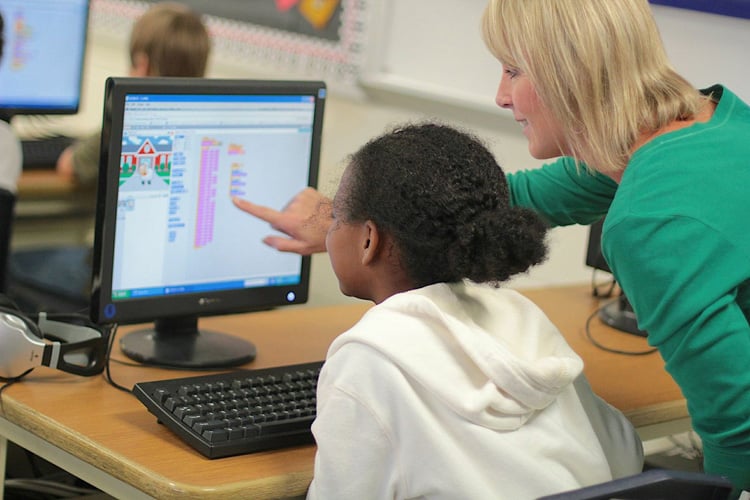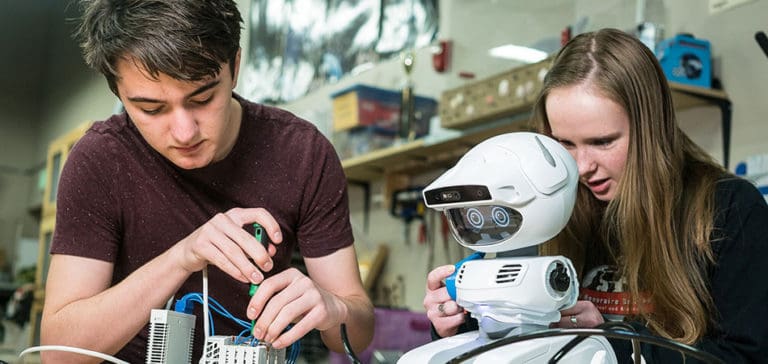AI Curricula for K-12 Classrooms
Don’t assume it will be years before you need to worry about AI in the curriculum you teach. Artificial intelligence already has seeped into nearly every facet of our lives. It’s been permeating the fabric of our world, quite literally.
Wearable technology like smart yoga pants and running socks have taken fashion into the future with connected sensors that monitor body data and measure workout efficacy. We rely on smart surveillance, smart vehicles, and smartphones to get us through our days. Why wouldn’t we also use smart curricula?
It shouldn’t come as a surprise that artificial intelligence already plays a role in many classrooms. Schools have been redesigning how students learn by embedding the first phase of AI into the grades K-12 curriculum.

- 0 Comments
- Nov 15, 2019 10:00:00 AM
- Posted by Natalia Galvis
- Topics: EdTech, STEM, Education, Artificial Intelligence, STEMchat, Edchat, AI, Digital Technology
Using Artificial Intelligence to Boost Student Retention Rates
Tertiary institutions struggle with low retention rates. Only 40% of students complete a 4-year degree within 6 years at the same institution where they started their studies.
Student retention is a matter of great importance to institutions. For institutions that depend on tuition, low retention rates have serious financial consequences. That is apart from the huge negative implications for students should they opt not to continue their studies. Universities and colleges are under increasing pressure to retain students. Many states support tertiary institutions financially based on the number of students that graduates, not the number that enrolls.

- 0 Comments
- Nov 14, 2019 10:00:00 AM
- Posted by Natalia Galvis
- Topics: EdTech, STEM, Education, Artificial Intelligence, STEMchat, Edchat, AI, Digital Technology
Classroom Projects for a Digital Age
Classroom learning today has left the age of flipping through textbooks to follow along with the teacher, at least not for every class lesson. Teachers today are taking advantage of the use of digital devices and media to expand learning opportunities beyond a pencil and paper assignment. And, assessment is no longer just a multiple choice test.

Consider changing your usual assessment to one of these projects:
- 0 Comments
- Nov 13, 2019 10:00:00 AM
- Posted by Natalia Galvis
- Topics: EdTech, STEM, Education, STEMchat, Edchat, Digital Technology
10 Resources for EdTech Grants
Regardless of your specific position in education, you may find it necessary at one point in your career to pursue funding for educational technology. While education technology is primarily funded at the state and federal level, there are multitudes of local grants you can apply for as well. You should carefully consider all possible funding sources when searching for money to pay for your newest classroom innovation.

- 0 Comments
- Nov 12, 2019 12:46:33 PM
How Coding Should be Taught To Kids
Parents and educators across the country understand the importance of teaching kids how to code. Not only can it help them learn valuable skills that they can use into their technology-driver future, but it also helps them learn to approach problems differently. But determining the best method for teaching a child to code isn’t always obvious.
In most cases, people agree that a traditional textbook approach is insufficient for subjects like coding. While the idiosyncrasies of the language can be introduced that way, it is difficult to assimilate the information until it is in use fully. But sticking children in front of a blank screen and having them write line after line, though functional, isn’t very inspiring or even interesting.

If you want to capture the interest of young students while giving them access to a valuable skill set, then turning to games may be the ideal method.
- 0 Comments
- Nov 11, 2019 10:15:00 AM
- Posted by Natalia Galvis
- Topics: Robotics, EdTech, STEM, Education, Coding, Codificación, STEMchat, Edchat
Robotics, The Next Big Thing in Higher Education?
Without a doubt, robotics is the next big thing in education. Like it or not, robots and robotics are the future. The sooner we accept robotics in schools and educate our children about robotics, the more prepared they will be for that future. At the moment, robotics is a reality at universities around the world, but imagine the possibilities if children entered those college programs already equipped with some robotic knowledge.

In this article, we have listed some interesting stories from universities to prove that there is already quite an interest in robotics after high school.
- 0 Comments
- Nov 8, 2019 10:00:00 AM
Why EdTech Companies Should Hire Educators
With the rise of new edtech companies, the competition to succeed in the industry grows each year. In 2016, the industry raised over 1 billion dollars. Staying ahead of the game and focusing on ways to outperform the competition is necessary for startups to stay alive. However, many companies are ignoring a valuable resource which they need for continued success. What is this untapped reservoir?
The answer you might not expect is teachers. Edtech companies often focus on technology development, testing, and integration. However, a significant number of them are doing so without the input of education professionals. What do traditional educators have to offer edtech companies? In short, a lot. Here are the most significant reasons edtech companies need to employ teachers.

- 0 Comments
- Nov 7, 2019 10:10:00 AM
Is STEM Education Working, Especially for Women?
STEM education remains in the spotlight 25 years after the term first emerged. Coined in the 1990s by the National Science Foundation, the acronym is applied to any curricula, event, policy or education program addressing Science, Technology, Engineering or Math. Most often it references Science and Math, but all four areas have become hot topics in the general education of K-12 students. The emphasis carries through to higher education and beyond, seeking to prepare young adults to assume 21st century worthy jobs. Anticipated areas of need include employees who are interactive as problem solvers, researchers, designers, and engineers.

- 0 Comments
- Nov 6, 2019 10:10:00 AM
- Posted by Natalia Galvis
- Topics: EdTech, STEM, STEMchat, WomeninSTEM, Edchat, girlsinSTEM
How to Develop a Successful Makerspace
In the United States, a trend has been established to encourage STEM learning (science, technology, engineering, and mathematics) through Makerspaces and other critical thinking programs. Makerspaces are providing the needed for space for human collaboration and teamwork which can include the use of anything from 3D printers to Robotics equipment to hand tools to Legos.

- 0 Comments
- Nov 5, 2019 10:00:00 AM
- Posted by Natalia Galvis
- Topics: EdTech, STEM, Makerspace, STEMchat, Edchat
5 Ways That Technology can Expand Creativity in Higher Education
Creativity has always been a part of a successful classroom, however recent advances in technology are making it possible to increase the ability for students to use their creativity in academia. With the ability to take and store thousands of pictures and videos, and listen to music in the palms of our hands, our students have the ability to be more and more creative in their projects, assignments, as well as group and individual tasks. As universities are encouraging the expansion and use of technology in the classroom, many professors are also encouraging the development of their students’ creative minds.

- 0 Comments
- Nov 4, 2019 10:00:00 AM
- Posted by Natalia Galvis
- Topics: EdTech, STEM, Technology, STEMchat, Edchat, Digital Technology
Relevant Posts
Popular Posts
Subscribe to Email Updates
-
I Want To Learn MoreADDITIONAL INFORMATION


